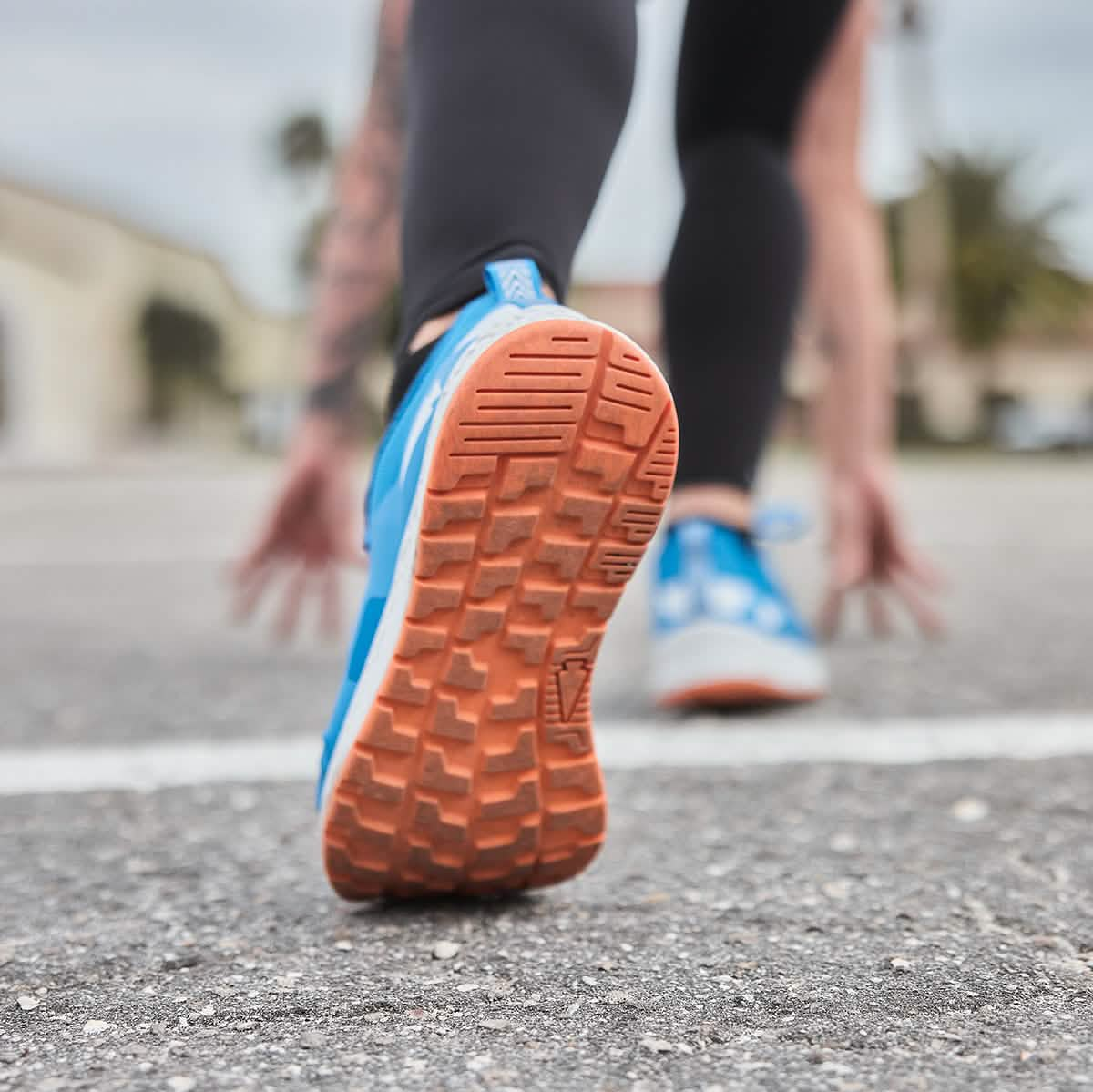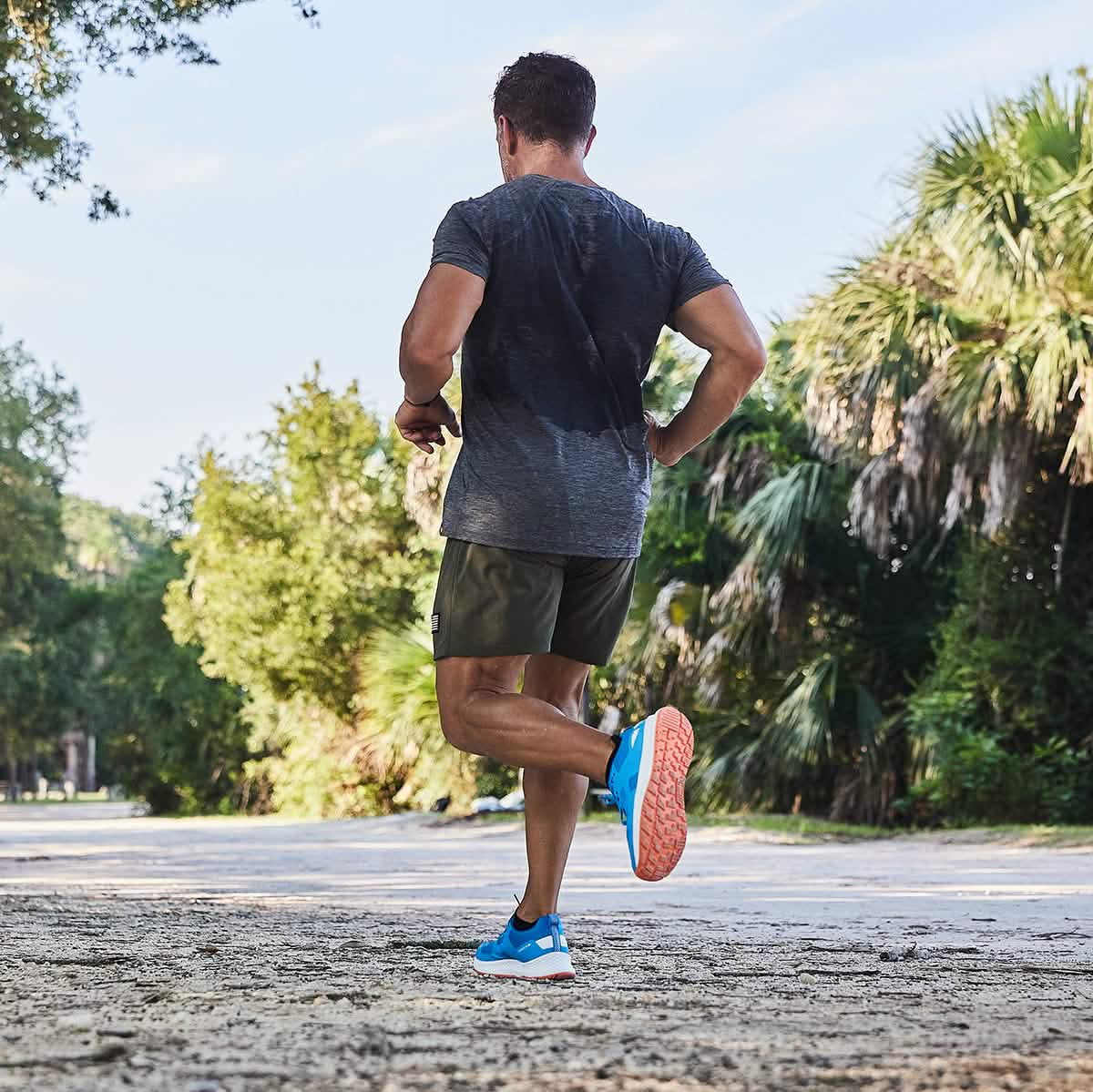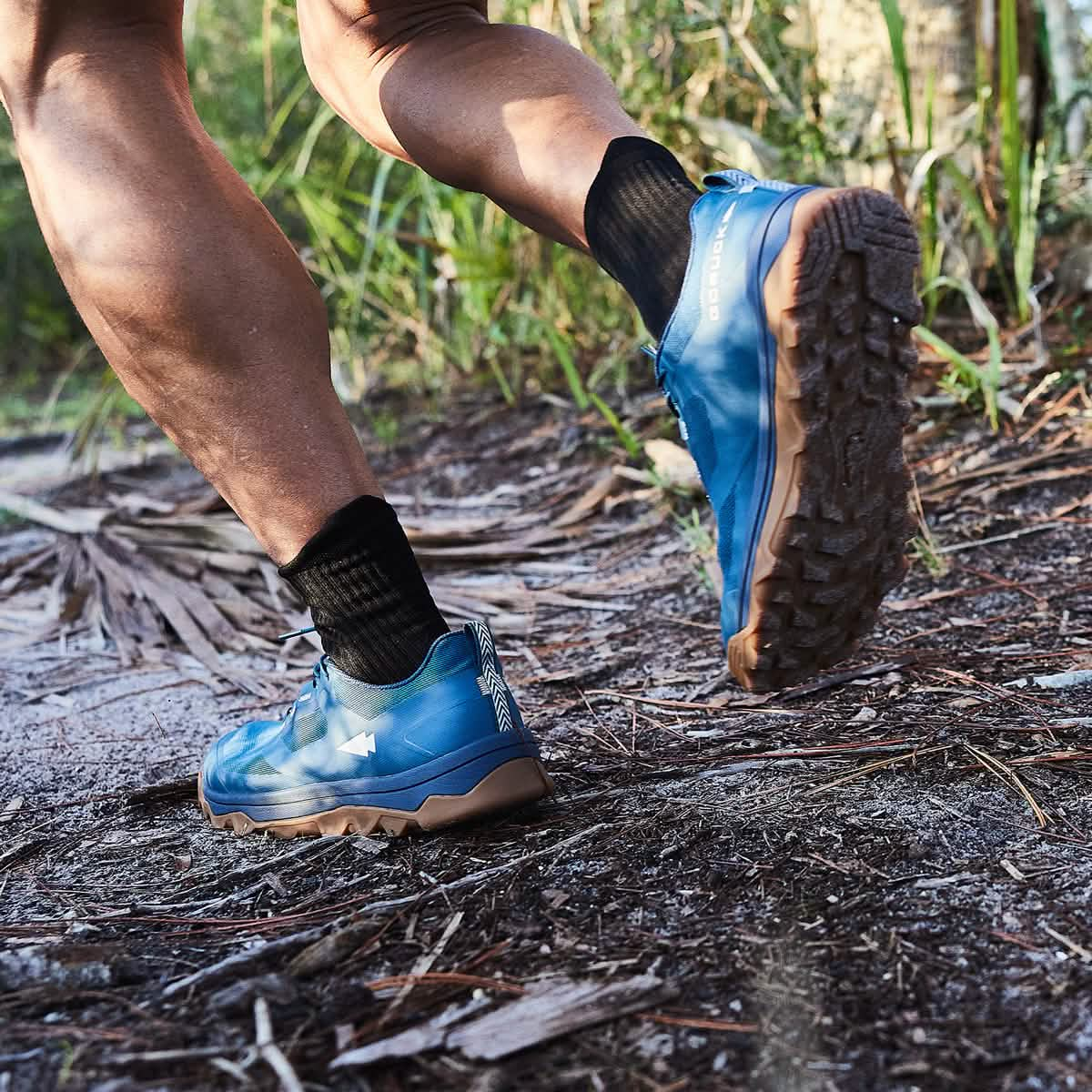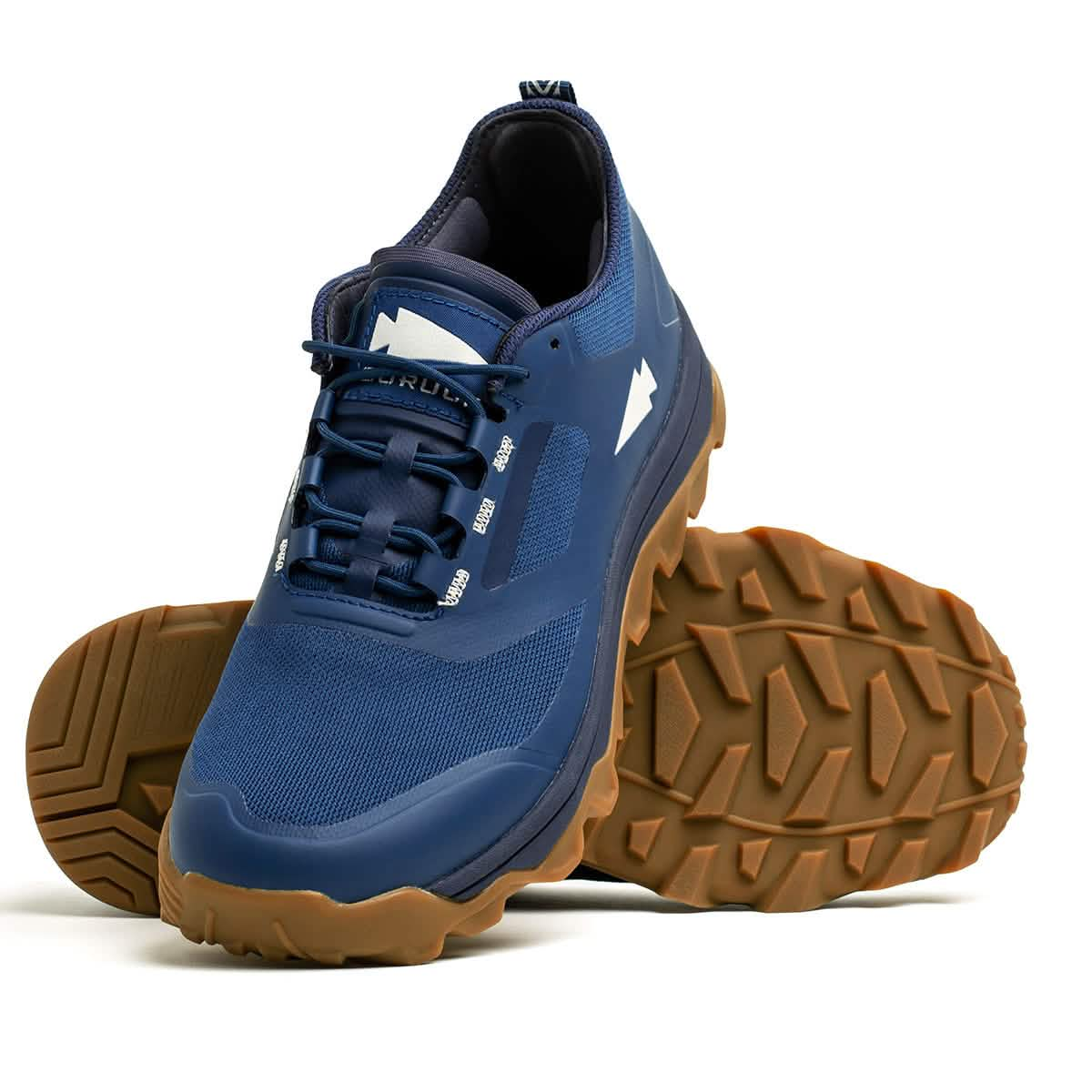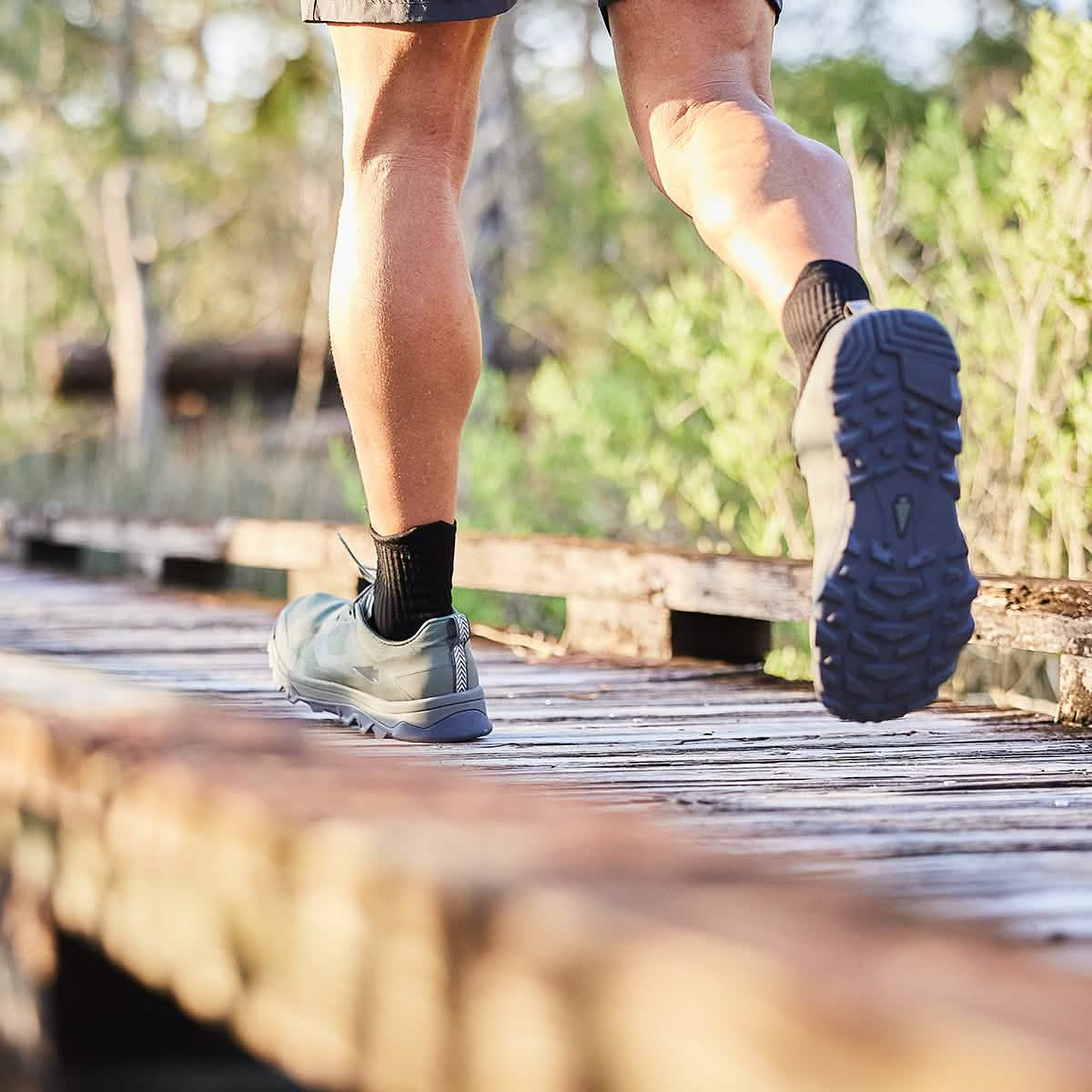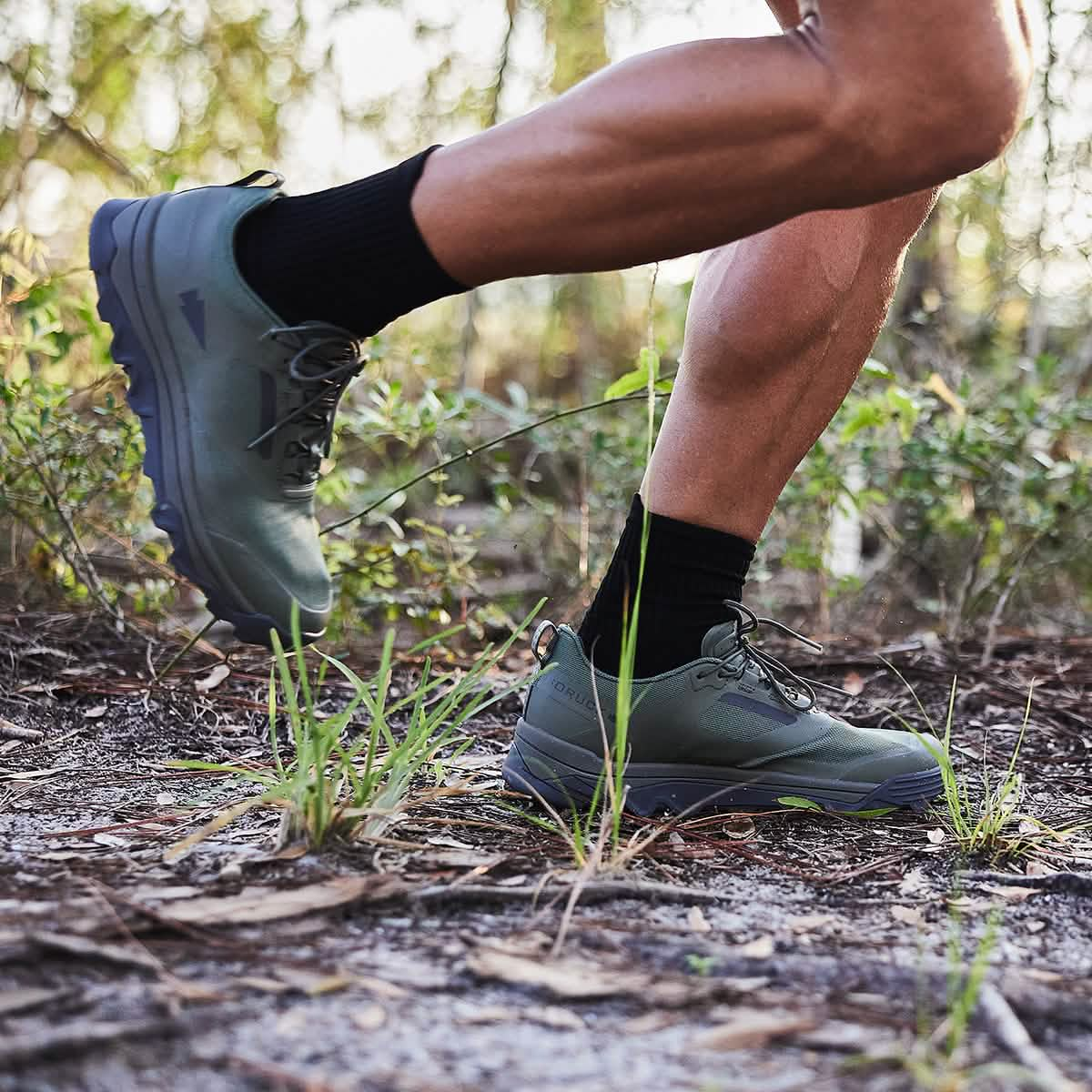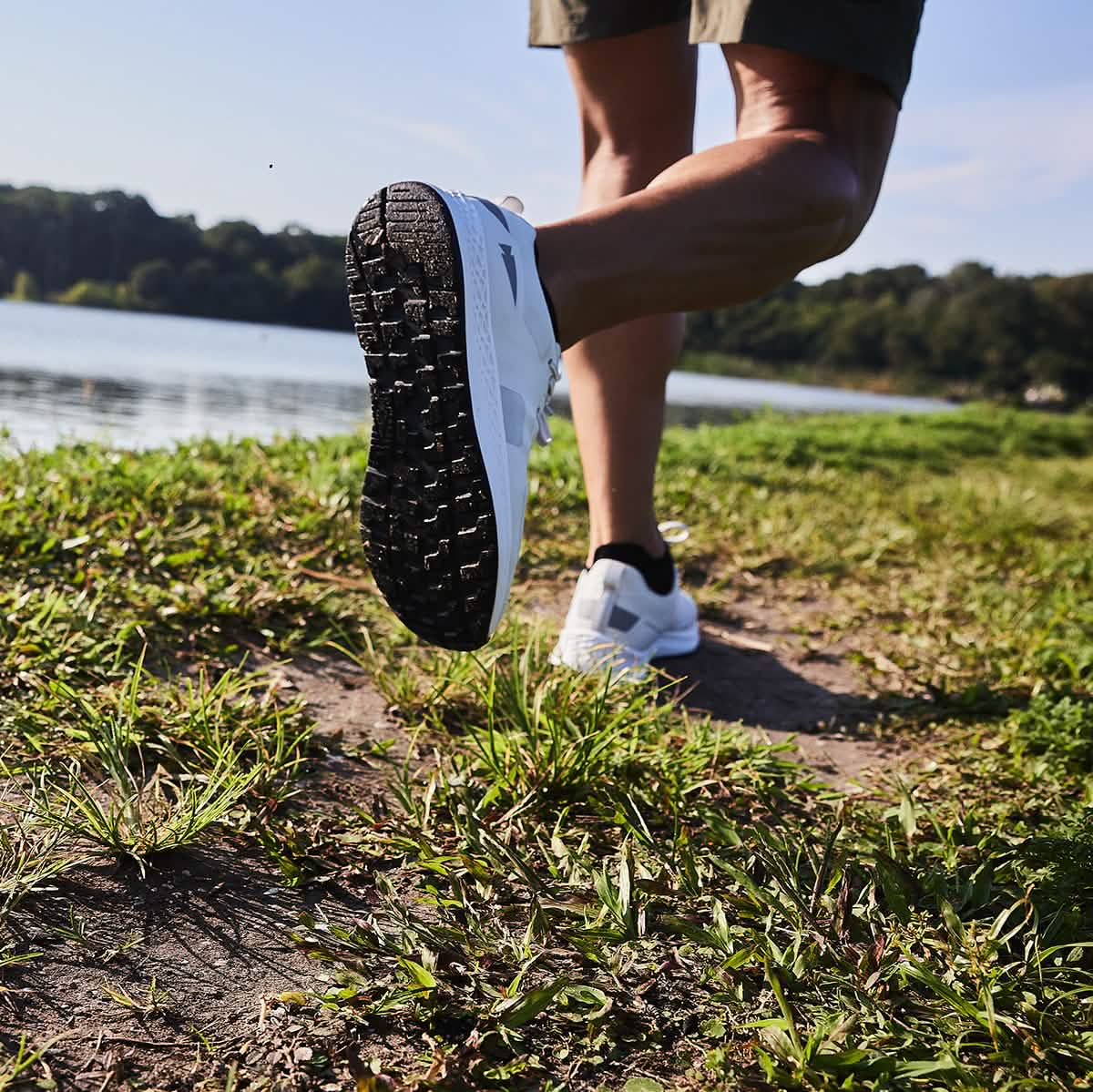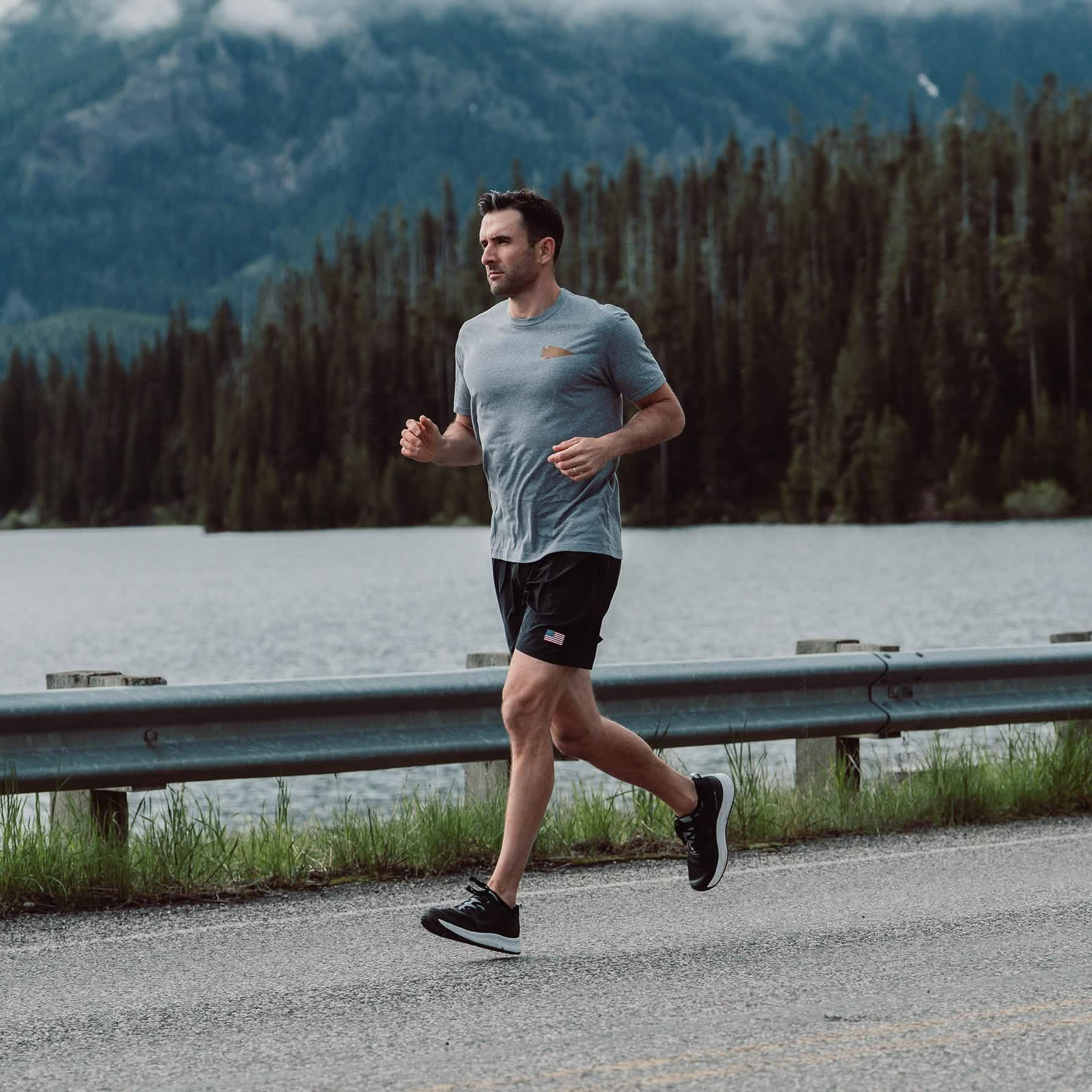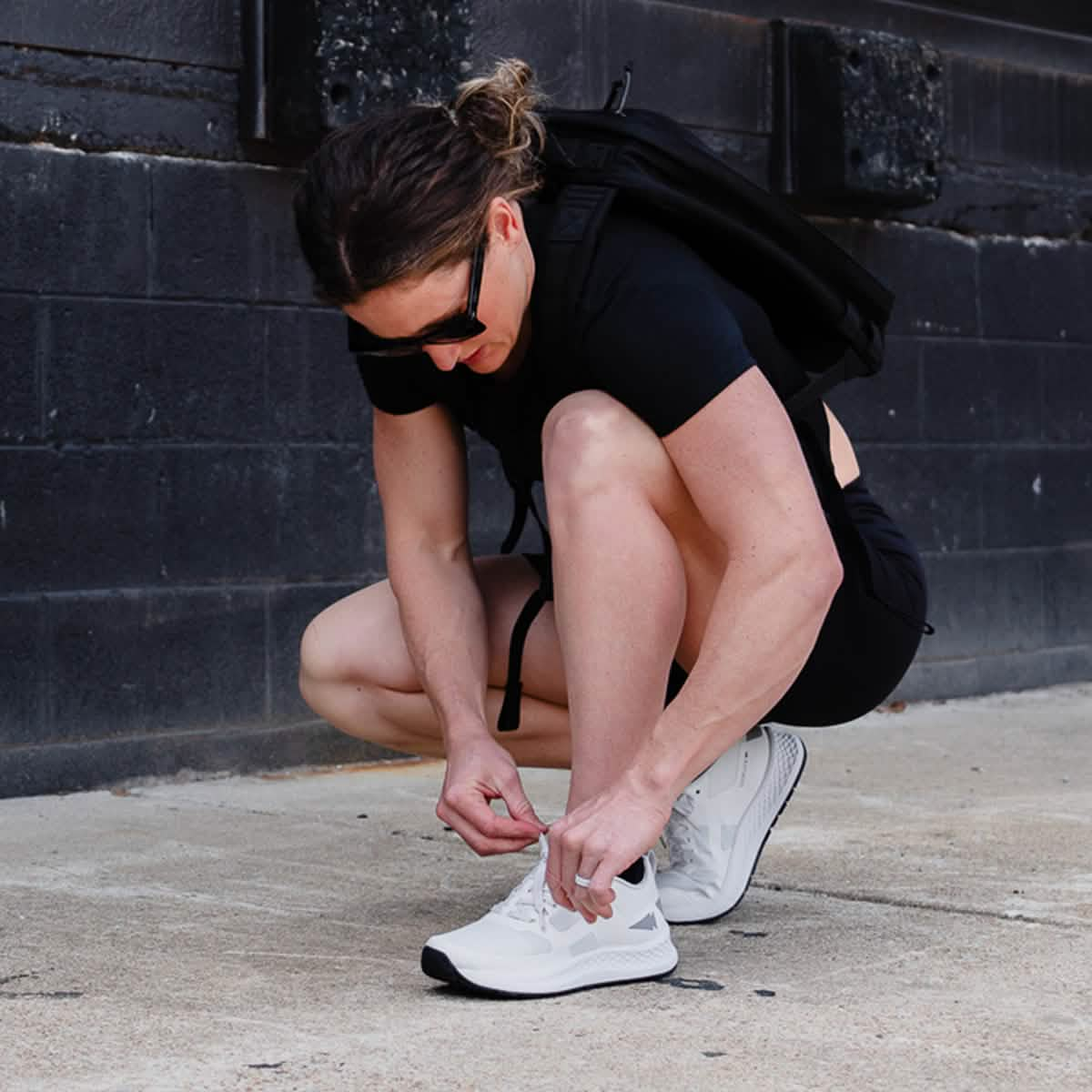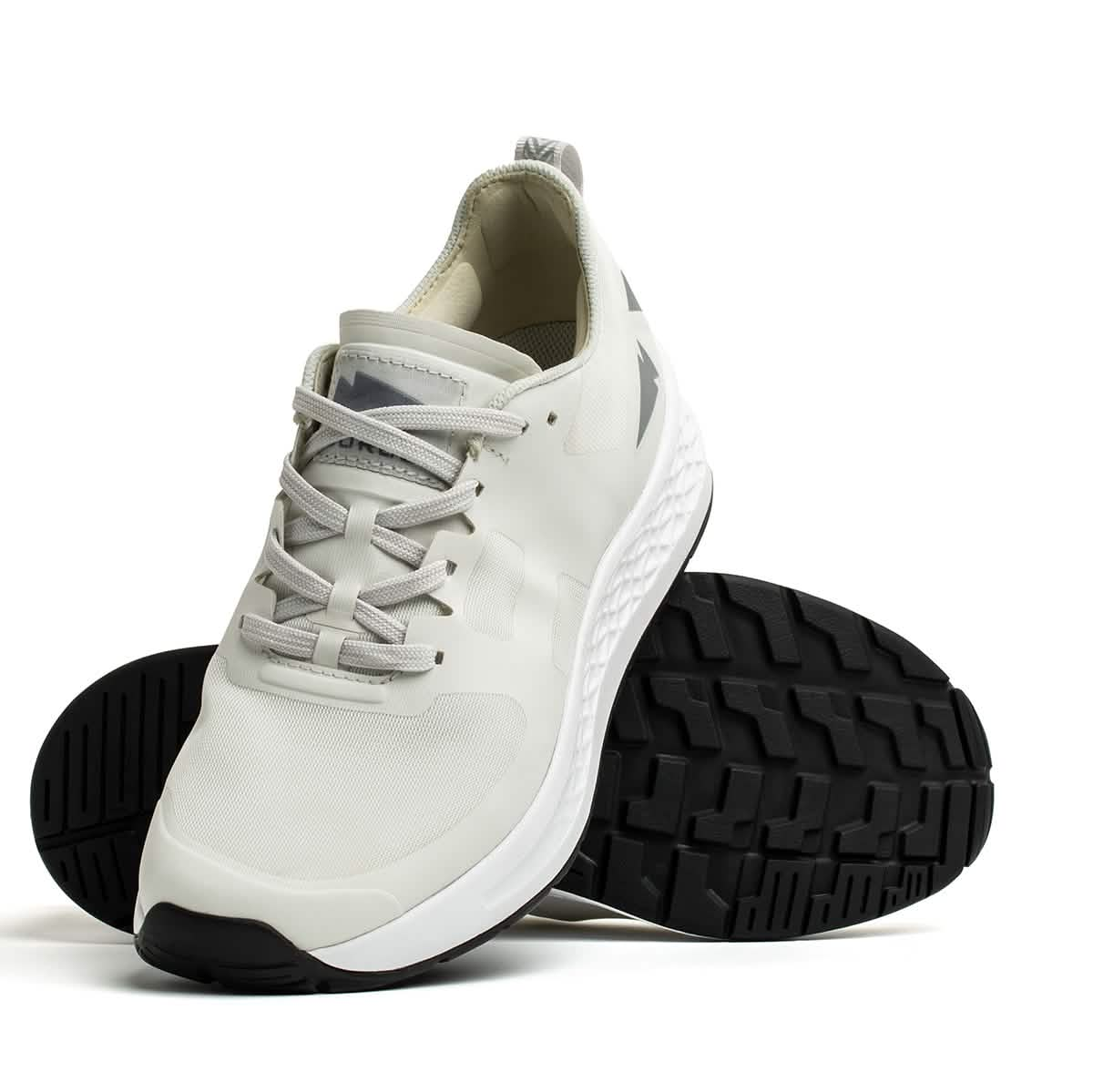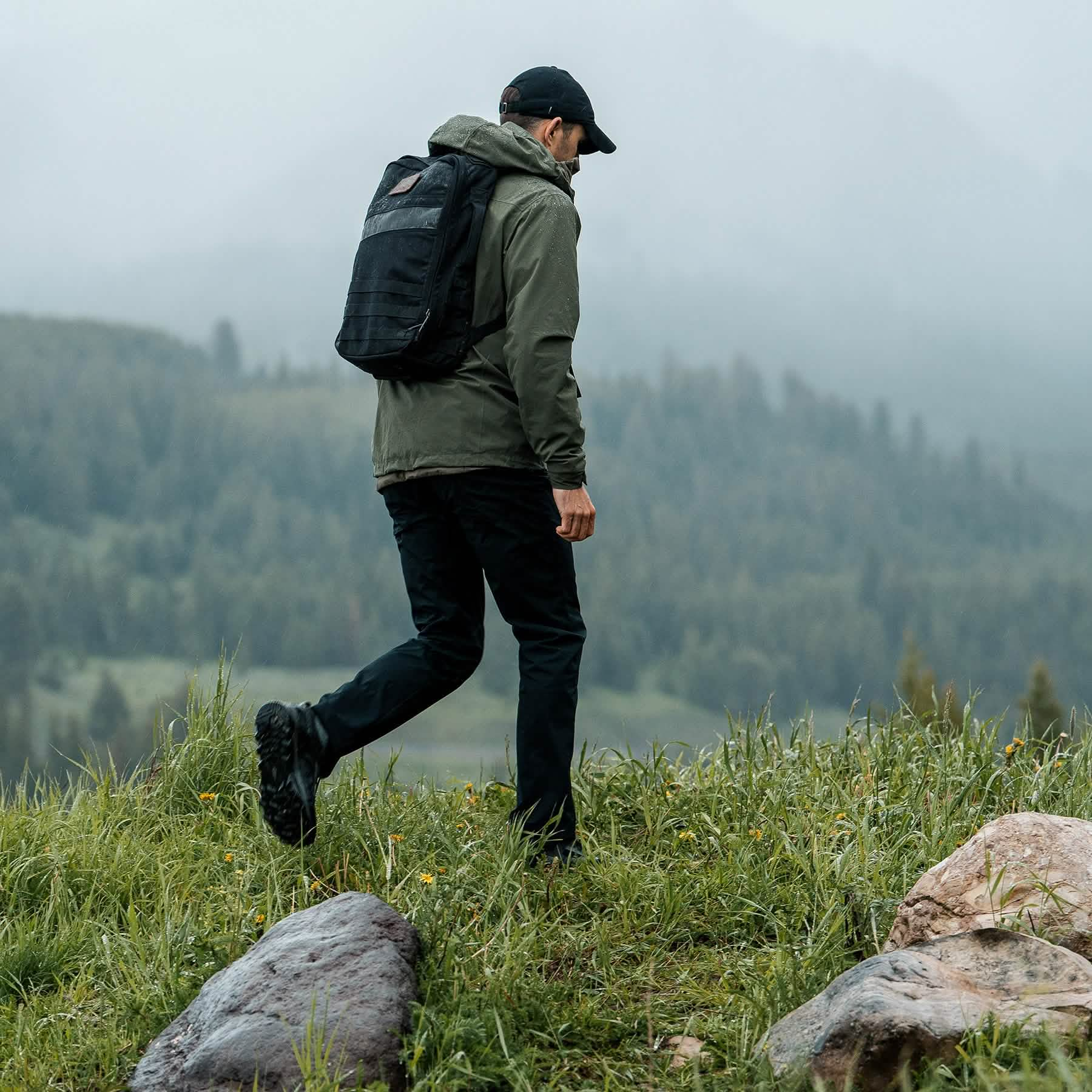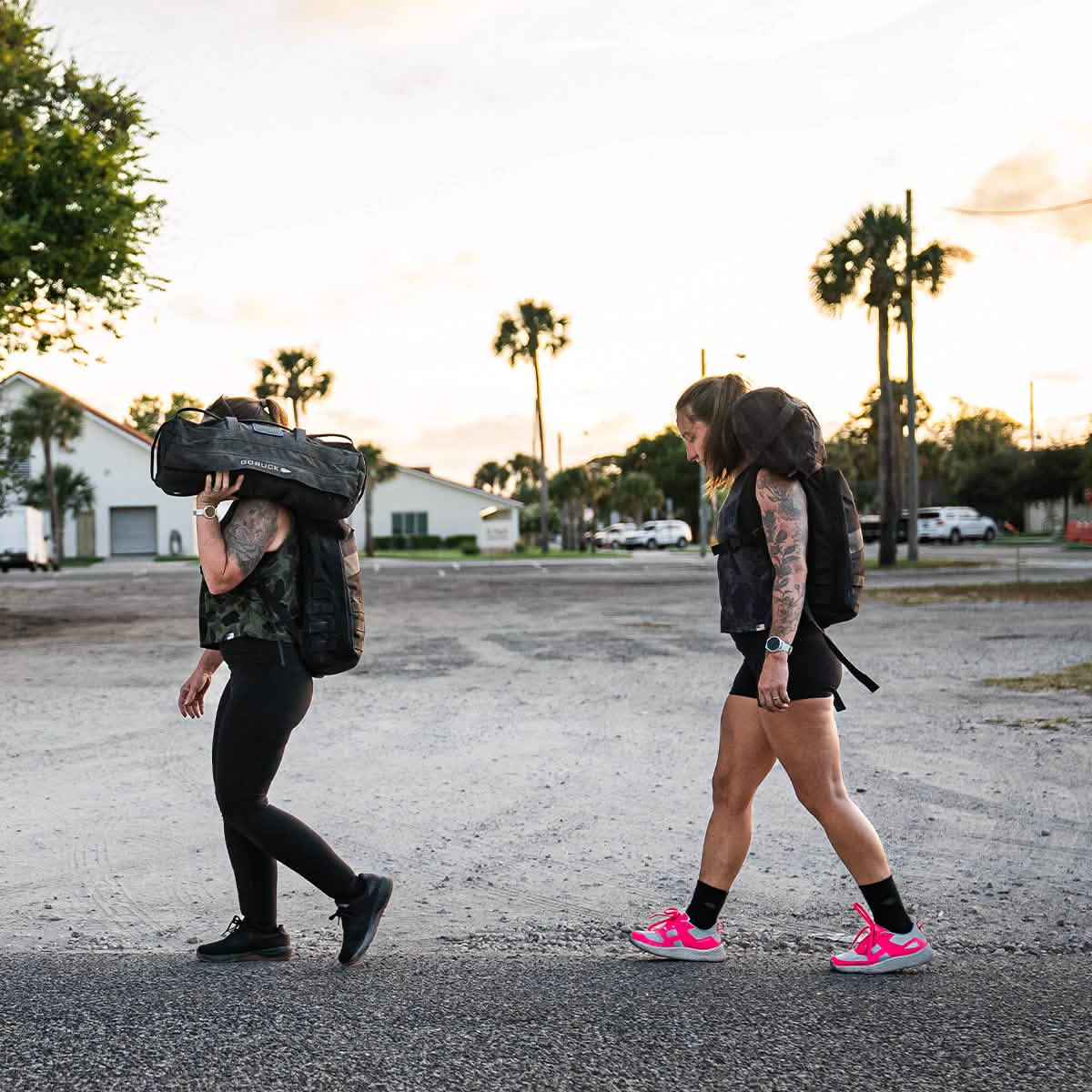Choosing the best running shoes starts with one question: are you pounding pavement or exploring dirt trails? That's the first split in the family tree of running shoes: trail running shoes vs running shoes.
So which option is better for you? Are there any in between running shoes that can handle pavement and trails? What should you look for when choosing trail running or road running shoes?
We've been pounding pavement and running on trails for decades (sometimes with weight--that's called rucking), so we've got a pretty good handle on this running shoe conversation. In fact, in 2024 GORUCK became the Official Footwear Provider of CrossFit because of our knowledge and expertise on running shoes, trail shoes, and training shoes.
Providing shoes to the best functional fitness athletes in the world is a serious responsibility, and providing great running and rucking shoes to our customers is a great privilege.
Let's check out what we look for in trail running shoes vs road running shoes, and which you might want. We'll also discuss a hybrid option that might be the best of both worlds.
Table of Contents: Jump Ahead
What All Running Shoes Need
Not all shoes make good running shoes. Running is hard on shoes, even if you're only running a few days per week. But when you buy purpose-built running shoes (shoes designed for the demands of running), your shoes should last longer and take better care of your body.
Here's what to look for when you're buying running shoes, no matter if they're trail running shoes or road running shoes...
1. Rubber outsole
Make sure your running shoes have a rubber outsole that covers the bottom of the shoe. Exposed foam isn't super common on good running shoes, but you'll find it on many bargain brand athletic shoes. Running shoes from big box stores are a risky purchase, and your first quality check should be the rubber coverage on the bottom.
Now, you'll find some shoes in run specialty stores meant for speed that have some foam visible underneath. Less rubber means a lighter shoe. But most of us are putting in lots of miles at a variety of paces and should look for an outsole covered in rubber.
2. Soft (but not too soft) foam
Marshmallow-soft running shoes are all the rage right now, but we're not buying the hype. Why not? Running shoes that are too soft will have more give than you need. In other words, your feet will sink in to your pillow-soft running shoes as you run. These super soft shoes tend to be heavier and less efficient.
You want running shoes that have some responsiveness. That means you'll have a spring in your step, rather than your foot sinking into the shoe.
Comfort is important when you're picking out trail running or road running shoes, but soft doesn't always mean more comfortable over many miles. Check out a running shoe's customer reviews for feedback on how comfortable a shoe stays after hours of wear.
3. Breathable upper
A breathable upper (the material on top of the shoe) means your feet won't suffocate when it's hot out. Also, running shoes with a breathable upper dry quickly to prevent odor and keep them ready for your next run. Whether you're running in rain and puddles or hot, sweaty weather, find running shoes with a lightweight, airy upper.
Waterproof shoes don't make great running shoes, unless you regularly run in sub-freezing temperatures and need something warm. Waterproof running shoes aren't breathable, so your feet will get hot and sweaty, even if the temperatures outside are cool.
A breathable upper in trail and road running shoes is essential to foot health and comfort.
4. Purpose-built design
We've mentioned this a bunch, but don't buy just any shoes for running. Read reviews and make sure people are actually running in the shoes you're considering. Your friend's favorite cross trainers or your uncle's go-to hiking shoes aren't necessarily the shoes you should be running in.
Great running shoes (ones that will last for lots of miles and take care of your body) will have a rubber outsole, a breathable upper, and feel responsive underneath. They should also feel more stable and secure than the other shoes in your closet--especially in the heel and under your foot's arch.
Finally, running shoes shouldn't cram your toes. Find something with a toe box that lets your toes wiggle a bit. A thumbs-width distance between your big toe and the end of the shoe is ideal.
5. Lots of reviews
Seriously, read reviews. And make sure there're plenty to read! When you can scroll through hundreds of reviews, you'll find people with your problems and preferences. Choosing the best running shoes is a personal process, but other peoples' thoughts and feedback can help you make the best decisions.
Trail Running Shoes vs Running Shoes
Alright, so what's the deal with trail running shoes? Can't you just wear regular running shoes on your trail runs? Do you need another pair of shoes for running on trails?
Trail Running Shoes Features
Trail running shoes are built specifically for running on dirt trails, grass, or other soft, uneven surfaces. The most noticeable feature of trail running shoes vs running shoes are the deeper lugs, AKA tread, on the bottom. On soft surfaces, like dirt, you want your shoes to grab the ground and pull you forward.
You'll notice the tread under the forefoot faces the opposite direction of the tread under the heel. These are called directional lugs. What's up with that? Well, trail running often involves uphill and downhill running (trails wind through forests and up mountains, after all). When you're running uphill, the front tread will grab the hills and pull you up the hill.
When you switch to downhill running, the tread under your heel will prevent you from slipping down the hill, stabilizing your stride.
Deep tread with directional lugs is the biggest different between trail running and road running shoes.
But that's not all!
Trail running shoes often have more structure around the top of the foot (the upper is reinforced) and under the arch. More structure in these areas gives the foot more lateral stability, so when you step on roots and rocks you don't twist an ankle. Extra firmness in the midsole and arch support stabilizes the foot, too, and prevents hard impacts on roots and rocks.
Finally, trail running shoes should have a protective toe cap. There's plenty of tripping on roots and rocks in trail running, and a protective toe cap prevents stubbed toes. It protects the shoe from damage, too.
Can I wear my trail running shoes on pavement?
Pavement is harder on shoes, and the deeper tread of trail running shoes gets beat up quicker than the tread on road running shoes. Yes, you can wear trail shoes on concrete and asphalt, but if you're on paved surfaces more than a few miles per week, get yourself some road running shoes or hybrid running shoes. Keep reading for our recommendations on road and hybrid runners.
When to choose trail running shoes
Alright, so you've seen what a trail running shoe should look like. But when are they the right option for you? If you run only on unpaved surfaces, skip the regular running shoes and buy some trail running shoes. You're a trail runner.
Similarly, if local parks or mountain trails are your happy place, keep a pair of trail running shoes in your closet. They just make the experience better. Better traction, more stability and support, and comfort for hours running over dirt, roots, rocks, and streams.
Road Running Shoes Features
Unlike trail running shoes, regular running shoes won't have deep tread, but good ones will have rubber covering the bottom of the shoe. Generally, road running shoes are lighter weight than trail running shoes, too. That's due to less rubber underneath (no deep tread), less structure in the upper, and less stability around and under the foot.
Running shoes come in many shapes and sizes, but they're all meant to go forward without roots and rocks in the way. Yes, they can handle paved hills, but many will slip and slide on mountain trails. They're lighter, faster, and less stable than trail running shoes.
When to choose road running shoes
Road running shoes are best for people who do most or all of their training on concrete, asphalt, or tracks. Can they go on trails, too? Of course, but you'll notice the roots and rocks are harder on your feet, and you won't have quite as much traction. Your steps may not feel as stable, either, around turns or when the ground gets uneven.
Hybrid Running Shoes
Are you training on roads and trails? You might benefit from a hybrid running shoe, something that can pound pavement and tackle mountain trails, all in the same day. Rough Runners™ are lightweight, high-mileage running shoes that keep the lateral stability, structured upper, and reinforced toe cap popular in trail running shoes. They've also got tread that's somewhere between road and trail: aggressive tread, but without the deep lugs that can get worn down by paved surfaces.
Why do we give our best-selling running shoes superior stability, structure and support, and tread capable of rugged trail running? Because our roots are Special Forces, and we put our gear to work in a variety of environments. Our running shoes have to be light and responsive for road running, while keeping our ankles stable and feet safe from roots and rocks. Rough Runners™ can cross streams and do speed workouts at the track without missing a step.
If you're often between trails and roads, if you like running on sand, or if versatility is your favorite word, Rough Runners™ are built for you.
We run on roads, ruck on sand, and take our Rough Runners™ onto rugged trails. We'll drop for burpees and do box jumps in them, too.
When to choose hybrid running shoes
Hybrid running shoes like Rough Runners™ aren't common at specialty running stores. That's unfortunate for us runners who want something versatile. People often just use their road running shoes on trails, or keep two pairs of shoes handy (one for trails, one for roads). But a hybrid style shoe is perfect for anyone who switches regularly between different running surfaces.
Yes, you can have a shoe that is lightweight, good for high mileage, and stable for trail running.
We should know, we built it.
Rough Runners™ vs Mackall™
So whether you're looking for road running, trail running, or hybrid running shoes, we've got you covered. Road warriors, runners who switch between trail and road, or athletes who like burpees and body squats should use a hybrid running shoe, something that can handle the demands of intense, versatile training. If your GORUCK Club starts at the brewery and stays on sidewalks, Rough Runners™ can carry serious weight, too. They might be the lightest rucking shoes at your Club.
SOF Selection Tested and Approved ⭐⭐⭐⭐⭐
"I just returned from Civil Affairs selection and am humbled to report that I was selected. I can't thank GORUCK enough for helping me get ready and execute the assessment. I finished 1st in all the rucking events...I used my Rough Runners whenever we were authorized running shoes and I completed all runs in the top 5. This equipment is excellent and I will continue to use as I prep for the Q Course."
-Timothy M.
If you're mostly trail running or love the GORUCK Challenge, choose Mackall™. Mackall™ was designed for rucking, trail running, and hiking. It's the lightweight, off-road workhorse of our Special Forces-inspired footwear lineup.
While Rough Runners™ have versatile tread that is efficient on pavement and has enough traction for trail, Mackall™ is made for dirt, grass, roots, rocks, and mud. If you're rucking on pavement, you'll appreciate the stability and support of Mackall™, and when you stop at a local park to perform PT, they'll excel on the uneven surfaces.
Great Rucking Shoes for this first-timer ⭐⭐⭐⭐⭐
"I just got into rucking over the past few months-starting off just in my neighborhood with whatever regular shoes I had. I've done hiking in the past in my twenties, but now in my mid-forties, I wanted to get back into it. Inspired by Michael Easter's "The Comfort Crisis," I wanted to explore rucking more, especially in nature. Enter the Mackall...I used them today for the first time on trails with a 30 lb pack and they did not disappoint....I love the wide platform and support and responsiveness of the shoe, especially under load. I can't wait to put more miles on them. Thank you, GORUCK."
-Andrew
Both Rough Runners™ and Mackall™ are lightweight for running (10.5 oz and 13.5 oz, respectively), stable for rucking and trail running, and come with built-in arch support that contours to the natural shape of the foot. Inspired and built by Army Special Forces soldiers, they're comfortable, durable, and reliable on various surfaces.
Shoes For Life
We only build gear for life. That means our footwear--including our running shoes--are designed with versatility in mind. We mix things up, after all. We run, ruck, hike, and hang out in our shoes because they're supremely comfortable and durable. They happen to look great, too.
Our trail and road running shoes won't go out of function, or style. They're just that good. And when something is that good, we stick with it. You will, too.
If you have any questions about GORUCK footwear, or trail running shoes vs running shoes, reach out.



